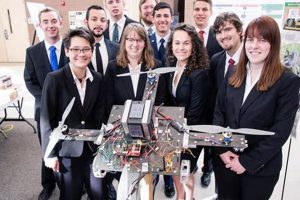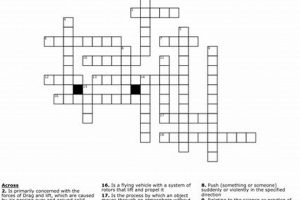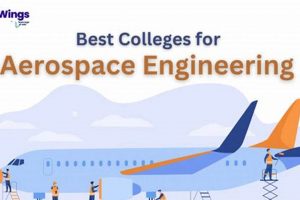The curriculum encompasses a broad range of scientific and mathematical principles directly applicable to the design, development, and operation of aircraft and spacecraft. Students engage with subjects such as aerodynamics, propulsion, structural analysis, control systems, and orbital mechanics. For example, aerodynamics courses explore fluid dynamics and lift generation, while propulsion courses delve into the thermodynamics and mechanics of jet engines and rocket motors.
Mastery of these subjects is vital for ensuring the safety, efficiency, and performance of aerospace vehicles. Historically, advancements in these areas have led to significant breakthroughs in air travel, space exploration, and national defense. A solid grounding in these fundamental concepts prepares graduates for careers in research, development, testing, and manufacturing within the aerospace industry and related fields.
The specific topics covered reflect the dynamic and evolving nature of the field. As such, modern programs often incorporate elements of computer-aided design (CAD), computational fluid dynamics (CFD), and materials science to address contemporary challenges in areas like unmanned aerial vehicles (UAVs), hypersonic flight, and sustainable aerospace technologies. This interdisciplinary approach equips graduates with the skills necessary to innovate and contribute to future advancements in aerospace.
Guidance from Core Aerospace Engineering Principles
A firm grasp of the fundamental principles underpins success in aerospace engineering. Consider the following guidance, derived directly from the knowledge domain:
Tip 1: Prioritize a Strong Mathematical Foundation: The discipline relies heavily on calculus, differential equations, linear algebra, and statistics. Solid proficiency in these areas facilitates deeper understanding of complex concepts and analytical problem-solving.
Tip 2: Develop Proficiency in Computational Tools: Modern aerospace engineering utilizes software for design, simulation, and analysis. Familiarity with CAD software, finite element analysis (FEA) tools, and computational fluid dynamics (CFD) is essential.
Tip 3: Cultivate a Thorough Understanding of Aerodynamics: Aerodynamic principles govern the behavior of airfoils, aircraft, and spacecraft. A deep understanding of lift, drag, and stability is crucial for efficient design.
Tip 4: Master Control Systems Theory: Aerospace vehicles rely on sophisticated control systems for stability and maneuverability. Comprehending feedback control, stability analysis, and system design is vital.
Tip 5: Embrace Materials Science: Understanding the properties of various materials is crucial for selecting appropriate materials for aerospace structures. This includes knowledge of strength, weight, thermal resistance, and corrosion resistance.
Tip 6: Emphasize Hands-on Experience: Supplementing theoretical knowledge with practical experience through projects, internships, or research opportunities enhances understanding and builds valuable skills.
Tip 7: Stay Current with Technological Advancements: The aerospace field is rapidly evolving. Continuously updating knowledge through journals, conferences, and professional development ensures competitiveness.
Adhering to these guidelines, derived from the core elements of aerospace engineering education, provides a solid foundation for success in the field. These principles are applicable across a wide range of specializations and career paths.
These tips underscore the necessity of a well-rounded education that combines theoretical knowledge with practical application. Continued dedication to learning and adaptation is crucial for navigating the complexities and challenges of the aerospace industry.
1. Aerodynamics
Aerodynamics, a fundamental component of aerospace engineering education, focuses on the study of air and other gaseous fluids in motion, specifically their interaction with solid objects. It forms the basis for understanding how aircraft fly, how spacecraft re-enter the atmosphere, and even how wind turbines generate energy. Its principles are integral to the design and optimization of aerospace vehicles.
- Fluid Dynamics and Flow Analysis
This aspect covers the fundamental principles governing fluid motion, including conservation of mass, momentum, and energy. Students learn to analyze different flow regimes, such as laminar and turbulent flow, and apply computational fluid dynamics (CFD) to simulate and predict aerodynamic performance. Real-world examples include wing design optimization and the analysis of airflow around complex aircraft configurations.
- Airfoil Theory and Wing Design
Airfoil theory delves into the aerodynamic characteristics of wing cross-sections, focusing on lift generation, drag reduction, and stall prevention. Students learn how to select and design airfoils for specific applications, considering factors such as speed, altitude, and maneuverability. This knowledge is crucial for designing efficient and stable aircraft wings, as seen in the evolution of wing designs from early biplanes to modern swept-wing configurations.
- Boundary Layer Phenomena
The boundary layer, the thin layer of fluid adjacent to a solid surface, significantly impacts drag and heat transfer. Students study boundary layer formation, transition to turbulence, and methods for boundary layer control, such as suction or blowing. Understanding boundary layer phenomena is essential for minimizing drag on aircraft and spacecraft, as demonstrated by laminar flow control technologies.
- Compressible Flow and Shock Waves
At high speeds, the compressibility of air becomes significant, leading to the formation of shock waves. Students learn about the behavior of compressible flows, including the formation and propagation of shock waves, and their impact on aerodynamic performance. This knowledge is critical for designing supersonic and hypersonic aircraft, such as the Concorde and the Space Shuttle.
These facets of aerodynamics are interconnected and essential for the design, analysis, and optimization of aerospace vehicles. The understanding of fluid dynamics, airfoil theory, boundary layer phenomena, and compressible flow ensures that aerospace engineers can create efficient, stable, and safe flying machines, underlining the importance of these topics within the broader curriculum.
2. Propulsion Systems
The study of propulsion systems is a cornerstone of aerospace engineering, representing the application of thermodynamic and fluid dynamic principles to generate thrust. Understanding these systems is paramount for enabling flight within the atmosphere and beyond.
- Thermodynamics and Gas Dynamics
This area covers the fundamental principles of thermodynamics and their application to gas behavior, particularly in the context of combustion and expansion processes within engines. Students learn about the thermodynamic cycles that govern engine performance, such as the Brayton cycle for gas turbines and the Rankine cycle for steam-based systems. Examples include analyzing the efficiency of jet engines and rocket nozzles, informing designs for improved thrust and fuel economy.
- Rocket Propulsion
Rocket propulsion focuses on the principles and technologies behind rocket engines, essential for spacecraft propulsion and space exploration. Students study various rocket engine types, including solid-propellant, liquid-propellant, and hybrid rockets. They analyze combustion processes, nozzle design, and propellant characteristics to optimize rocket performance. Real-world applications include the design of propulsion systems for satellites, launch vehicles, and interplanetary probes.
- Air-Breathing Engines
Air-breathing engines, such as turbojets, turbofans, and ramjets, are critical for aircraft propulsion within the Earth’s atmosphere. Students learn about the different types of air-breathing engines, their operating principles, and their performance characteristics. This includes analyzing the intake, compressor, combustor, and turbine sections of gas turbine engines. This knowledge informs design decisions for commercial aircraft, military jets, and unmanned aerial vehicles.
- Advanced Propulsion Concepts
Beyond conventional systems, aerospace engineering curricula also explore advanced propulsion concepts, such as electric propulsion, nuclear propulsion, and advanced chemical propulsion systems. Students investigate the potential of these technologies for future space missions, including long-duration interplanetary travel and high-efficiency in-space maneuvering. Examples include ion drives for deep-space probes and fusion reactors for future spacecraft.
Collectively, these facets of propulsion systems provide a comprehensive understanding of how aerospace vehicles are powered. Mastery of these concepts is essential for engineers involved in the design, development, and testing of propulsion systems across a wide range of aerospace applications. The integration of theoretical knowledge with practical application ensures that graduates are well-equipped to contribute to advancements in aerospace propulsion technology.
3. Structural Mechanics
Structural mechanics, a critical component of aerospace engineering education, focuses on the behavior of solid bodies subjected to various loads and environmental conditions. Its principles are vital for ensuring the safety, reliability, and longevity of aircraft and spacecraft structures. A thorough understanding of structural mechanics underpins the design and analysis of all aerospace vehicle components.
- Stress and Strain Analysis
This area covers the fundamental concepts of stress, strain, and their relationship within materials. Students learn to calculate stresses and strains under different loading conditions, such as tension, compression, shear, and bending. Examples include analyzing the stresses in an aircraft wing during flight or the strains in a spacecraft structure during launch. This knowledge is crucial for predicting structural failure and optimizing material selection.
- Finite Element Analysis (FEA)
Finite element analysis is a powerful numerical technique used to simulate the behavior of complex structures under load. Students learn to use FEA software to model aerospace components, apply boundary conditions, and solve for stresses, strains, and displacements. Real-world applications include the analysis of aircraft fuselages, rocket nozzles, and satellite solar panels. FEA enables engineers to identify critical stress concentrations and optimize structural designs for weight and performance.
- Material Properties and Selection
Understanding the properties of various materials is essential for selecting the appropriate materials for aerospace structures. Students learn about the mechanical properties of metals, composites, and ceramics, including strength, stiffness, fatigue resistance, and corrosion resistance. They also study the effects of temperature and environmental factors on material behavior. This knowledge is critical for designing lightweight, durable, and reliable aerospace structures, as exemplified by the use of carbon fiber composites in modern aircraft.
- Structural Stability and Buckling
Structural stability refers to the ability of a structure to resist sudden deformation or collapse under compressive loads. Students learn about buckling phenomena in columns, plates, and shells, and how to design structures to prevent buckling. This is particularly important for thin-walled aerospace structures, such as aircraft fuselages and rocket bodies. Examples include the analysis of buckling in aircraft wings and the design of stiffeners to prevent buckling in spacecraft structures.
These facets of structural mechanics provide a comprehensive framework for understanding the behavior of aerospace structures. Through the application of these principles, aerospace engineers can design and analyze structures that are safe, efficient, and capable of withstanding the extreme conditions encountered in flight and space. The study of structural mechanics is therefore indispensable for ensuring the integrity and performance of all aerospace vehicles, directly influencing their operational capabilities and safety standards.
4. Control Engineering
Control engineering, as taught within aerospace engineering curricula, provides the theoretical and practical tools necessary for designing and implementing systems that govern the behavior of aerospace vehicles. It is integral to achieving stable and predictable operation across a wide range of flight conditions, influencing everything from autopilot systems to trajectory control for spacecraft.
- Feedback Control Systems
Feedback control systems are a fundamental aspect. They involve using sensors to measure the actual state of a system (e.g., altitude, velocity) and comparing it to a desired state. The difference (error) is then used to adjust the system’s inputs to minimize the error. A common example is an aircraft autopilot, which continuously adjusts control surfaces to maintain a desired altitude and heading. This system, implemented through control algorithms, ensures stability and precise maneuvering, essential for safety and efficiency.
- Stability Analysis and Design
Stability analysis focuses on ensuring that a control system does not become unstable, leading to oscillations or runaway behavior. Students learn to analyze system stability using tools such as Bode plots, Nyquist plots, and root locus techniques. These analyses help determine the range of parameters for which the system remains stable. Proper stability design is critical in aerospace applications, preventing uncontrolled movements or structural stress, particularly in high-performance aircraft and spacecraft.
- Guidance and Navigation Systems
Guidance and navigation systems utilize sensors, algorithms, and control laws to determine the position and orientation of an aerospace vehicle and guide it along a desired trajectory. These systems often integrate GPS, inertial measurement units (IMUs), and Kalman filters to estimate the vehicle’s state accurately. Examples include the navigation systems used in commercial airliners and the guidance systems that steer spacecraft to precise orbital locations. Precise guidance and navigation are crucial for mission success and safety in flight and space.
- Autonomous Systems and Robotics
The development of autonomous systems is an increasingly important aspect. This involves creating vehicles that can operate with minimal human intervention, using sensors, onboard computers, and sophisticated control algorithms to make decisions and execute actions. Unmanned aerial vehicles (UAVs) and autonomous spacecraft are prime examples. The development of robust autonomous systems requires integrating advanced control techniques, artificial intelligence, and sensor fusion, representing a frontier in aerospace control engineering.
The principles of control engineering, as applied in the aerospace context, are essential for creating safe, reliable, and high-performance vehicles. By mastering these concepts, aerospace engineers can develop innovative solutions for controlling complex systems, contributing to advancements in air travel, space exploration, and autonomous vehicle technology. These systems are vital for not only the operation of flight vehicles but also future aerial and spatial innovations.
5. Spacecraft Design
Spacecraft design represents a culmination of various disciplines taught within aerospace engineering programs. It involves the holistic integration of aerodynamics (where applicable), propulsion, structural mechanics, control systems, and specialized knowledge related to the space environment. The ability to design functional and reliable spacecraft is a primary objective of aerospace engineering education.
- Orbital Mechanics and Mission Planning
Orbital mechanics forms the mathematical foundation for spacecraft trajectories and mission planning. Students learn to calculate orbital parameters, perform orbital maneuvers, and analyze the effects of perturbations on spacecraft orbits. This includes understanding Kepler’s laws, the two-body problem, and various coordinate systems used to describe spacecraft motion. A real-world example is the planning of a mission to Mars, which requires precise calculations of orbital transfer windows, delta-V requirements, and arrival conditions. The insights gained are then applied to determining launch windows, fuel budgets, and mission timelines, all essential components of “what is taught in aerospace engineering.”
- Space Environment and Protection
The space environment presents unique challenges to spacecraft design, including vacuum, extreme temperatures, radiation, and micrometeoroid impacts. Students study the effects of these factors on spacecraft materials, electronics, and thermal control systems. Protective measures, such as radiation shielding, thermal insulation, and micrometeoroid shielding, are critical for ensuring spacecraft longevity and reliability. For example, spacecraft operating in geostationary orbit must be designed to withstand high levels of radiation from the Van Allen belts. This knowledge informs the selection of materials and components that can survive the harsh conditions of space, reflecting a specialized aspect of “what is taught in aerospace engineering.”
- Power Systems and Thermal Management
Spacecraft require reliable power systems to operate their onboard equipment, and thermal management systems to maintain optimal operating temperatures. Students learn about various power generation methods, including solar arrays, radioisotope thermoelectric generators (RTGs), and fuel cells. They also study thermal control techniques, such as passive radiators, heat pipes, and active cooling loops. For instance, the International Space Station relies on large solar arrays to generate electricity and complex thermal control systems to dissipate waste heat. The design and analysis of these systems are integral to the teaching of spacecraft engineering principles.
- Attitude Determination and Control Systems (ADCS)
Attitude Determination and Control Systems (ADCS) are essential for maintaining the desired orientation of a spacecraft in space. Students study various sensors used to determine spacecraft attitude, such as star trackers, sun sensors, and gyroscopes. They also learn about different actuators used to control spacecraft attitude, such as reaction wheels, control moment gyros (CMGs), and thrusters. An example includes the James Webb Space Telescope, which requires extremely precise attitude control to point its instruments at distant galaxies. The development of robust ADCS systems is a key component of spacecraft engineering education and reflects the integration of control theory with practical application.
In conclusion, spacecraft design encapsulates a wide range of aerospace engineering knowledge and skills. The study of orbital mechanics, space environment, power systems, thermal management, and attitude control, demonstrates the interdisciplinary nature of “what is taught in aerospace engineering.” The design of spacecraft is a highly complex and challenging endeavor, requiring a strong foundation in fundamental engineering principles and a deep understanding of the space environment. Students who master these concepts are well-prepared to contribute to the advancement of space exploration and technology.
Frequently Asked Questions Regarding Aerospace Engineering Curricula
The following questions and answers address common inquiries concerning the scope and content of aerospace engineering education. These are intended to provide clarity and dispel misconceptions about this field of study.
Question 1: Does aerospace engineering primarily focus on aircraft or spacecraft?
Aerospace engineering encompasses both aircraft and spacecraft. Curricula typically cover aspects of aeronautical engineering (aircraft design and operation within the atmosphere) and astronautical engineering (spacecraft design and operation in space). Some programs allow for specialization in one area, but a foundational understanding of both is generally provided.
Question 2: What level of mathematics proficiency is required for aerospace engineering?
A high level of mathematics proficiency is essential. Courses require a strong understanding of calculus, differential equations, linear algebra, and statistics. These mathematical tools are used extensively in areas such as aerodynamics, structural analysis, and control systems.
Question 3: Is practical experience included in aerospace engineering programs, or is it purely theoretical?
Most programs incorporate practical experience through laboratory courses, design projects, and internships. These experiences allow students to apply theoretical knowledge to real-world problems and develop hands-on skills in areas such as CAD software, wind tunnel testing, and composite materials fabrication.
Question 4: How much computer programming is involved in aerospace engineering studies?
Computer programming is an important skill for aerospace engineers. Students learn to use programming languages such as MATLAB, Python, and C++ for data analysis, simulation, and control system design. Knowledge of programming is also crucial for working with computational fluid dynamics (CFD) and finite element analysis (FEA) software.
Question 5: What are the career prospects for graduates with an aerospace engineering degree?
Career prospects are typically strong, with opportunities in the aerospace industry, government agencies, and research institutions. Graduates may work in areas such as design, manufacturing, testing, research, and management. Specific roles include aerospace engineers, structural engineers, propulsion engineers, and control systems engineers.
Question 6: Is aerospace engineering a field that requires continuous learning and adaptation?
Yes, the aerospace field is constantly evolving due to technological advancements and emerging challenges. Therefore, continuous learning and adaptation are essential for aerospace engineers. Staying current with new technologies, participating in professional development activities, and pursuing advanced degrees are common strategies for career advancement.
Aerospace engineering requires a rigorous academic foundation, practical experience, and a commitment to lifelong learning. Individuals considering this field should be prepared for a challenging but rewarding career path.
Further sections of this document will address the application process and specific program requirements.
Conclusion
This exploration of what is taught in aerospace engineering reveals a curriculum grounded in fundamental scientific and mathematical principles, extending to complex design and analysis methodologies. Core areas of study, including aerodynamics, propulsion, structural mechanics, control engineering, and spacecraft design, are essential for equipping graduates with the competencies required to address the multifaceted challenges of the aerospace industry. Emphasis on practical application, through laboratory work, design projects, and computational simulations, is integral to solidifying theoretical knowledge.
Mastery of these diverse subjects is crucial for continued advancement in air travel, space exploration, and related technologies. The aerospace field necessitates constant learning and adaptation. Graduates must embrace ongoing professional development to contribute to future innovations and ensure the continued progress of aerospace engineering.







